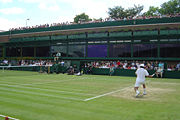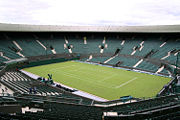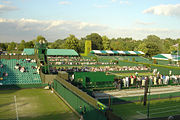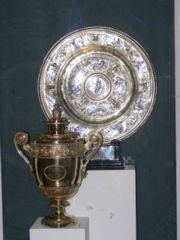The Championships, Wimbledon
2008/9 Schools Wikipedia Selection. Related subjects: Sports events
| The Championships, Wimbledon | ||
|---|---|---|
 |
||
| Grand Slam | ||
| Location | Wimbledon, London Borough of Merton |
|
| Venue | All England Club | |
| Surface | Grass / Outdoor | |
| Men's Draw | 128S / 128Q / 64D | |
| Women's Draw | 128S / 96Q / 64D | |
| Prize Money | £11,282,710 | |
| Official website | ||
| Grand Slam tournaments | ||
|
||
The Championships, Wimbledon, commonly referred to as Wimbledon, is the oldest major championship in tennis.
Held annually between late June and the beginning of July for two weeks (usually ending, at the latest, on the second Sunday of July) at the All England Lawn Tennis and Croquet Club in London, England, the tournament is the third Grand Slam event played each year, preceded by the Australian Open and the French Open, and followed by the U.S. Open. The tournament duration is subject to extensions for rain.
Separate tournaments are simultaneously held, all at the same venue, for Gentlemen's Singles, Ladies' Singles, Gentlemen's Doubles, Ladies' Doubles and Mixed Doubles. Youth tournaments – Boys' Singles, Girls' Singles, Boys' Doubles and Girls' Doubles – are also held. Additionally, special invitational tournaments are held: the 35 and over Gentlemen's Doubles, 45 and over Gentlemen's Doubles, 35 and over Ladies' Doubles and wheelchair doubles.
History
The Championships were first played under the control of the All England Lawn Tennis and Croquet Club in 1877 at a ground near Worple Road, Wimbledon; the only event held was Gentlemen's Singles. In 1884, the All England Club added Ladies' Singles and Gentlemen's Doubles. Ladies' Doubles and Mixed Doubles were added in 1913. The Championships moved to their present location, at a ground near Church Road, in 1922. As with the other three Grand Slam events, Wimbledon was contested by top-ranked amateur players until the advent of the open era in tennis in 1968. Britons are very proud of the tournament, though it is a source of national anguish and humour – no British man has won the singles event at Wimbledon since Fred Perry in 1936, and no British woman since Virginia Wade in 1977. The Championship was first televised in 1937.
Events
There are five main events held at Wimbledon: Gentlemen's Singles, Ladies' Singles, Gentlemen's Doubles, Ladies' Doubles and Mixed Doubles. In addition, four events are held for juniors: Boys' Singles, Girls' Singles, Boys' Doubles and Girls' Doubles. (The Mixed Doubles event is not held at the junior level.) Finally, four invitational events are held: the 35 and over Gentlemen's Invitation Doubles, the 45 and over Gentlemen's Invitation Doubles, the 35 and over Ladies' Invitation Doubles and the Wheelchair Gentlemen's Invitation Doubles.
Matches in the Gentlemen's Singles and Gentlemen's Doubles competitions are best-of-five sets; matches in all other events are best-of-three sets. Most events are single-elimination tournaments; in other words, a player who loses a single match is immediately eliminated from the tournament. However, the 35 and over Gentlemen's Invitation Doubles and the 35 and over Ladies' Invitation Doubles are both round-robin tournaments.
Up through 1921, the winners of the previous year's competition (except in the Ladies Doubles and Mixed Doubles) were automatically granted byes into the final round (then known as the challenge round). This led to many winners retaining their titles for successive years, as they were able to rest while their opponent competed from the start of the competition. From 1922, the title holders played through from the start of the championships.
Each year, the tournament begins on the Monday falling between 20 and 26 June (six weeks before the first Monday in August). It is held two weeks after the Queen's Club Championships, which are considered the major warm-up period for Wimbledon for male players. Another important warm-up tournament for the men is the Gerry Weber Open, which is held in Halle, Germany at about the same time as the Queen's Club Championships. The other grass-court male tournaments before the Championships are currently 's-Hertogenbosch in the Netherlands (which also organises an event for women), and Nottingham in Britain. To adapt to the fast green surface there are also two more competitions for women, the places to host these are Birmingham and Eastbourne (both in the UK). Wimbledon usually lasts for two weeks; the main events span both weeks, but the junior and invitational events are for the most part held during the second week. Traditionally, there is no play on the "Middle Sunday", which is considered a rest day. However, rain has forced play on the Middle Sunday three times in the Championship's history: in 1991, 1997, and 2004. On each of these occasions, Wimbledon has staged a "People's Sunday", with unreserved seating and readily available, inexpensive tickets, allowing those with more limited means to sit on the show courts. Additionally, if the tournament is not completed by the end of the second Sunday, all the remaining matches are postponed until "People's Monday". The grass-court season comes to an end each year after the Championships, when the short tournament of Newport invites male players to its grounds in the U.S.
Players and seeding
A total of 128 players feature in each singles event, 64 pairs in each single-sex doubles event, and 48 pairs in Mixed Doubles. Players and doubles pairs are admitted to the main events on the basis of their international rankings, with consideration also given to their previous performances at grasscourt events. Currently (since 2001) 32 male and female players are given seedings in the Gentlemen's and Ladies' singles while 16 teams are seeded in the doubles events.
The Committee of Management and the Referee evaluate all applications for entry, and determine which players may be admitted to the tournament directly. The committee may admit a player without a high enough ranking as a wild card. Usually, wild cards are players who have performed well during previous tournaments, or would stimulate public interest in Wimbledon by participating. The only wild card to win the Gentlemen's Singles Championship was Goran Ivanišević (2001). Players and pairs who neither have high enough rankings nor receive wild cards may participate in a qualifying tournament held one week before Wimbledon at the Bank of England Sports Ground in Roehampton. The singles qualifying competitions are three-round events; the same-sex doubles competitions last for only one round. There is no qualifying tournament for Mixed Doubles. No qualifier has won either the Gentlemen's Singles or the Ladies' Singles tournaments. The furthest that any qualifier has progressed in the main draw of a Singles tournament is the semi-final round: John McEnroe in 1977 and Vladimir Voltchkov of Belarus in 2000 (Gentlemen's Singles), and Alexandra Stevenson in 1999 (Ladies' Singles).
Players are admitted to the junior tournaments upon the recommendations of their national tennis associations, on their International Tennis Federation world rankings and, in the case of the singles events, on the basis of a qualifying competition. The Committee of Management determines which players may enter the four invitational events.
The Committee seeds the top players and pairs (thirty-two players in each main singles events, and sixteen pairs in each main doubles event) on the basis of their rankings. However, the Committee does also change the seedings due to a player's previous grass court performance. A majority of the entrants are unseeded. Only two unseeded players have ever won the Gentlemen's Singles Championship: Boris Becker in 1985 and Goran Ivanišević in 2001. (In 1985 there were only sixteen seeds - Becker was ranked 20th at the time; Ivanišević, however, was as low as 125th.) No unseeded player has captured the Ladies' Singles title; the lowest seeded female champion was Venus Williams, who won in 2007 as the twenty-third seed, beating her own record from 2005, when Williams won as the fourteenth seed. Unseeded pairs have won the doubles titles on numerous occasions; the 2005 Gentlemen's Doubles champions were not only unseeded, but also (for the first time ever) qualifier.
Grounds
The nineteen courts used for Wimbledon are all composed purely of rye grass. The speed of 100% rye grass is much slower than the 80% rye grass mix previously used for the courts. This means that serve and volley players are no longer dominant on the surface which now favours baseliners, and has seen Wimbledon fall from being the fastest Grand Slam to the 3rd fastest, behind the U.S. Open and Australian Open. Among women, the serve and volley strategy has been less common since around 1980.
The main show courts, Centre Court and No. 1 Court, are normally used only for two weeks a year, during the Championships, but play can extend into a third week in exceptional circumstances. The remaining seventeen courts are regularly used for other events hosted by the All England Lawn Tennis and Croquet Club. The show courts will, however, be pressed into action for the second time in three months in 2012 as Wimbledon will host the tennis events of the 2012 Olympic Games.
Wimbledon is the only Grand Slam event played on grass courts. At one time, all the other Grand Slam events were played on grass. The French Open abandoned grass for its current red clay in 1928, while the U.S. and Australian Opens stayed with grass for decades longer. The U.S. Open abandoned grass for a synthetic clay surface in 1975 and changed again to a hard surface ( DecoTurf) with its 1978 move to its current venue. The Australian Open abandoned grass for Rebound Ace, a different type of hard surface, in 1988, and switched to yet another type of hard surface, Plexicushion, in 2008.
The main court, Centre Court, was opened in 1922 when the All England Lawn Tennis and Croquet Club moved from Worple Road to Church Road. This change of venue was due to the huge crowd pressure at Worple Road to see the French phenomenon Suzanne Lenglen, and for which it proved completely inadequate.
Due to possibility of rain during Wimbledon, a retractable roof is planned for the court, which is expected to be completed in 2009. The retractable roof is said to be designed to close/open in under 10 minutes and will be closed primarily to protect play from inclement (and, if necessary, extremely hot) weather during The Championships. Also, during the time of its opening/closing, play will be suspended. The court has a capacity of almost 14,000. At its south end is the Royal Box, from which members of the Royal Family and other dignitaries watch matches. Centre Court usually hosts the finals and semifinals of the main events, as well as many matches in the earlier rounds involving top-seeded players or local favourites.
The second most important court is No. 1 Court. The court was constructed in 1997 to replace the old No. 1 Court, which was adjacent to Centre Court. The old No. 1 Court was demolished because its capacity for spectators was too low. The court was said to have had a unique, more intimate atmosphere and was a favourite of many players. The new No. 1 Court has a capacity of approximately 11,000. The third-largest court, No. 2 Court, has been dubbed the "Graveyard of Champions" due to its reputation as the court on which many seeded players have been eliminated during the early rounds. Famous players who have lost on the Graveyard during early round play include John McEnroe, Boris Becker, Andre Agassi, Pete Sampras, Martina Hingis, Venus Williams, and Serena Williams. The court has a capacity of about 3,000. There are plans to build a brand new 4,000 capacity No. 2 Court where No. 13 Court currently stands in time for the 2009 Championships.
At the northern end of the grounds is a giant television screen on which important matches are broadcast. Fans watch from an area of grass officially known as the Aorangi Terrace, but more commonly called Henman Hill. The "hill" takes its name from local favourite Tim Henman, who many fans once hoped would become the first British man to win the tournament since Fred Perry did so in 1936. When other British players do well at Wimbledon, the hill attracts fans for them, and is often re-named by the press for them: Greg Rusedski's followers convened at "Rusedski Ridge", and the young Scotsman Andy Murray has had the hill nicknamed "Murray Mound", "Mount Murray", or "Murray Field" (after the Scottish rugby stadium).
Traditions
Colours and uniforms
Dark green and purple (sometimes also referred to as mauve) are the traditional Wimbledon colours. Green clothing was worn by the chair umpire, linesmen, ball boys and ball girls through the 2005 Championships; however, beginning with the 2006 Championships, officials, ball boys and ball girls were outfitted in new navy blue and cream coloured uniforms from American designer Ralph Lauren. This marked the first time in the history of the Championships that an outside company was used to design Wimbledon clothing. As of June 2006, Wimbledon's contract with Ralph Lauren is set to last until 2009.
Players
The All England Club requires players to wear "almost entirely white" clothing during matches (used as an excuse by a young Andre Agassi for not playing the tournament in 1990, although his decision may have had more to do with his game at the time being unsuited to grass; he later won the competition). No other Grand Slam tournament has such a strict dress code for players. During matches, female players are always referred to by the title "Miss" or "Mrs"; married female players were formally referred to by their husband's names: for example, Chris Evert-Lloyd appeared on scoreboards as "Mrs. J. M. Lloyd" during her marriage to John M. Lloyd. This custom has been abandoned; the title "Mr" is never used for male players.
Royal Family
Previously, players bowed or curtsied to members of the Royal Family seated in the Royal Box upon entering or leaving Centre Court. In 2003, however, the President of the All England Club, HRH The Duke of Kent, decided to discontinue the tradition. Now, players are required to bow or curtsy only if the Queen or the Prince of Wales is present.
Strawberries and cream
For the spectators, strawberries and cream is the traditional snack at Wimbledon. Approximately 62,000 pounds of strawberries and 1,540 gallons of cream are sold each year during the Championships.
Radio Wimbledon
Since 1992, Radio Wimbledon – an on-site radio station with a studio in the Centre Court building – has broadcast commentary, music and speech from 8am to 10pm daily throughout the championship. They also broadcast the draw on the Friday prior to the start of the tournament. Radio Wimbledon can be heard within a five-mile radius on 87.7 FM, and also online. It operates under a Restricted Service License and is arguably the most sophisticated RSL annually in the UK. The main presenters are Sam Lloyd and Nick Dye. Typically they work alternate four hour shifts. Reporters and commentators include Gigi Salmon, Nick Lestor, Rupert Bell, Nigel Bidmead, Guy Swindells, Lucie Ahl, Nadine Towell and Helen Whitaker. Often they will report from the "Crow's Nest", an elevated building housing the court 2 and 3 scoreboards which affords views of most of the outside courts. Regular guests include Sue Mappin. In recent years Radio Wimbledon acquired a second low-power FM frequency (within the grounds only) of 96.3 FM for uninterrupted Centre Court commentary, and, from 2006, a third for coverage from No. 1 Court on 97.8 FM. Hourly news bulletins and travel (using RDS) are also broadcast.
Television Coverage
For over 60 years, the BBC has broadcast the tournament on television in the UK, splitting time for the many matches it covers between its two main terrestrial channels, BBC One and BBC Two. During the days of British Satellite Broadcasting, its sports channel carried extra coverage of Wimbledon for subscribers, and the BBC annually distributes its commercial-free feed to outlets worldwide. Americans have made a tradition of NBC's "Breakfast at Wimbledon" specials on the weekends, where live coverage starts early in the morning (the US being a minimum of 5 hours behind the UK) and continues well into the afternoon, interspersed with commentary and interviews from Bud Collins, whose tennis acumen and (in)famous patterned trousers are well-known to tennis fans in the USA. Collins was fired by NBC in 2007, but was promptly hired by ESPN, the cable home for The Championships in the States.
Wimbledon was also involved, unintentionally, in a piece of television history, on 1 July 1967. That was when the first, official, colour broadcast took place in the UK. Four hours live coverage of Wimbledon was shown on BBC2 (then the only colour channel in the UK), and although footage of that historic match no longer survives, the men's final that year is still held in the BBC archives, for it was the first men's final transmitted in colour.
From 2007, the most anticipated Wimbledon matches are transmitted in High Definition, on the BBC's free-to-air channel BBC HD, with continual live coverage during the tournament of Centre Court and Court No. 1 as well as an evening highlight show ( Today at Wimbledon).
Tickets
Wimbledon is the only major grand slam where fans without tickets for play that day can queue up and still get seats on Centre Court, Court 1 and Court 2. Usually there are 2 queues and each are allotted about 250 seats for each court. Fans are handed vouchers when they arrive in their queue with a number on it and the following morning when the line moves towards the Grounds, stewards come through the line and hand out wristbands that are colour coded to the specific court. The voucher is then redeemed at the ticket office for the ticket.
To get into the show courts, fans will normally have to queue overnight at Wimbledon. This is done by fans from all over the world and is considered part of the Wimbledon experience in itself. Tennis enthusiasts planning to queue overnight for the Championships are advised to bring along a tent and a sleeping bag. Times to queue up vary according to the weather, but anyone queueing up before 9PM on a weekday should be able to get a show court ticket. Queuing for the show courts end after the quarter finals have been completed.
Trophies and prize money
The Gentlemen's Singles champion receives a silver gilt cup 18.5 inches (about 47 cm) in height and 7.5 inches (about 19 cm) in diameter. The trophy has been awarded since 1887 and bears the inscription: "The All England Lawn Tennis Club Single Handed Champion of the World." The Ladies' Singles champion receives a sterling silver salver commonly known as the " Venus Rosewater Dish", or simply the "Rosewater Dish". The salver, which is 18.75 inches (about 48 cm) in diameter, is decorated with figures from mythology. The winners of the Gentlemen's Doubles, Ladies' Doubles, and Mixed Doubles events receive silver cups. The runner-up in each event receives an inscribed silver plate. The trophies are usually presented by the President of the All England Club, The Duke of Kent, and by his wife, the Duchess of Kent.
At Wimbledon, more prize money was traditionally awarded in the Gentlemen's events than in the Ladies' events. However, as of 2007 prize money is equal at all levels (in part in response to a powerful protest by tennis player Venus Williams). This makes Wimbledon policy identical to that of the Australian Open, US Open, and most recently the French Open. In 2005, Wimbledon prize money exceeded a total of £10 million (£10,085,510) total for the first time. The sums awarded to the winners of each of the main events in 2007 are as follows (the amounts shown for the doubles events are per pair):
- Gentlemen's Singles Winner £700,000 (US $1,408,181.53)
- Ladies' Singles Winner £700,000 (US $1,408,181.53)
- Gentlemen's Doubles Winners £222,900 (US $448,405.23)
- Ladies' Doubles Winners £222,900 (US $448,405.23)
- Mixed Doubles Winners £90,000 (US $181,051.91)
This was the first year that both the Gentlemen's and Ladies' Singles had the same prize money. Total prize money at Wimbledon 2007 was nearly 9% more than in 2006.
Champions
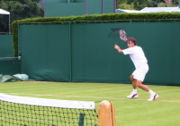
Among the four major titles, Wimbledon is the one that generates the most anxiety for the British. This is due to the fact that not only has no British player won a Wimbledon singles title since 1977, but no Brit has even been in the singles finals since then. Therefore, all the British (especially the English) usually will rally around a single countryman to bring back the glory. In the recent past, the retired Tim Henman was the most prominent hope. Andy Murray has become the next hope to rally around.
- Gentlemen's Singles
- Ladies' Singles
- Gentlemen's Doubles
- Ladies' Doubles
- Mixed Doubles
Records
| Record | Era | Player(s) | Count | Winning Years |
|---|---|---|---|---|
| Gentlemen since 1877 | ||||
| Winner of most Gentlemen's Singles titles | Before 1968: | 7 | 1881-86, 1889 | |
| After 1968: | 7 | 1993-95, 1997-2000 | ||
| Winner of most consecutive Gentlemen's Singles titles | Before 1968: | 6 | 1881-86 | |
| After 1968: | 5 | 1976-80 2003-07 |
||
| Winner of most Gentlemen's Doubles titles | Before 1968: | 8 | 1897-1901, 1903-05 | |
| After 1968: | 9 | 1993-97, 2000 (with Mark Woodforde), 2002-04 (with Jonas Björkman) | ||
| Winner of most consecutive Gentlemen's Doubles titles | Before 1968: | 5 | 1897-1901 | |
| After 1968: | 5 | 1993-97 | ||
| Winner of most Mixed Doubles titles - Gentlemen | Before 1968: | 4 | 1963, 1965-66, 1968 (with Margaret Court) 1953-56 (3 with Doris Hart, 1 with Shirley Fry Irvin) |
|
| After 1968: | 4 | 1967, 1971, 1973-74 (with Billie Jean King) | ||
| Winner of most Championships (total: singles, doubles, mixed) - Gentlemen | Before 1968: | 13 | 1897-1906 (5 singles, 8 doubles) | |
| After 1968: | 9 | 1993-2004 (9 doubles) | ||
| Ladies since 1884 | ||||
| Winner of most Ladies' Singles titles | Before 1968: | 8 | 1927-30, 1932-33, 1935, 1938 | |
| After 1968: | 9 | 1978-79,1982-1987, 1990 | ||
| Winner of most consecutive Ladies' Singles titles | Before 1968: | 5 | 1919-1923 | |
| After 1968: | 6 | 1982-1987 | ||
| Winner of most Ladies' Doubles titles | Before 1968: | 12 | 1914 (with Agatha Morton), 1919-23, 1925 (with Suzanne Lenglen), 1926 (with Mary Browne), 1927, 1930 (with Helen Wills), 1933-34 (with Simone Mathieu) | |
| 10 | 1961-62 (with Karen Hantze Susman), 1965 (with Maria Bueno), 1967-68, 1970-71, 1973 (with Rosie Casals), 1972 (with Betty Stove), 1979 (with Martina Navrátilová) | |||
| After 1968: | 7 | 1976 (with Chris Evert), 1979 (with Billie Jean King), 1981-84, 1986 (with Pam Shriver) | ||
| Winner of most consecutive Ladies' Doubles titles | Before 1968: | 5 | 1919-23 | |
| After 1968: | 4 | 1981-84 1991 (with Larisa Neiland), 1992-94 ( Gigi Fernandez) |
||
| Winner of most Mixed Doubles titles - ladies | Before 1968: | 7 | 1919, 1921, 1923 (with Randolph Lycett), 1927 (with Frank Hunter), 1928 (with Patrick Spence), 1930 (with Jack Crawford), 1932 (with Enrique Maier) | |
| After 1968: | 4 | 1985 (with Paul McNamee), 1993 (with Mark Woodforde), 1995 (with Jonathan Stark), 2003 (with Leander Paes) | ||
| Winner of most Championships (total: singles, doubles, mixed) - ladies | Before 1968: | 20 | 1961-1979 (6 singles, 10 doubles, 4 mixed) | |
| 19 | 1914-1934 (12 doubles, 7 mixed) | |||
| After 1968: | 20 | 1976-2003 (9 singles, 7 doubles, 4 mixed) | ||
| Miscellaneous | ||||
| Most matches played (men) | 223 | |||
| Most matches played (women) | 326 | |||
| Loser of most singles finals (men or women) | 7 | |||
| Lowest-ranked Winner (men or women) | 125th | |||
| The only wildcard Winner (men or women) | 2001 | |||
| Lowest ranked Winner (women) | 31st (23rd seed) | |||
Wimbledon in popular culture
- Episode seven of the TV show Monty Python's Flying Circus features a tennis-playing blancmange that attempts to win Wimbledon by turning otherwise normal people into Scotsmen (as, according to the show, Scotland is the "worst tennis-playing nation on Earth"), but is eaten mid-match by one Mr and Mrs Brainsample.
- In Bon Voyage, Charlie Brown (and Don't Come Back!!) (1980), Snoopy plays tennis at Wimbledon.
- Wimbledon, a 2004 film staring Paul Bettany and Kirsten Dunst as tennis stars.
- In an episode of Family Guy, Peter Griffin talks about sneaking into the tournament.
- In the episode Kamp Krusty in The Simpsons, Krusty the Klown is at Wimbledon when he should be at the camp.
- Get Fuzzy: On April 20, 2007, as Satchel is reading a Wikipedia entry about Bucky's debut album, Bucky implores Satchel to "scroll down to the bit about where I won Wimbledon."
